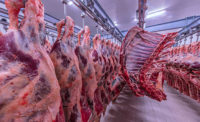Antimicrobial dips and sprays are an integral part of a strong food safety system. They benefit not only in bacterial reduction and suppression, but also improve the shelf life of products.
“They are being very widely employed in the industry right now, targeting everything from pathogenic E. coli for beef trims and Salmonella for poultry,” says Jim Dickson, a professor in the department of animal science at Iowa State University, in Ames.
Antimicrobial interventions are part of Cargill’s overall food safety system that uses a multiple-hurdle approach and also includes sanitary handling practices, cold chain management and other tools to reduce the potential human health risk from and presence of pathogens during the harvest and fabrication process.
“The focus going forward will be on the use of chemical blends that help our customers maintain clean labels for the protein products we sell, improve workplace safety for our employees and are friendly to the environment,” says Dan Etzler, director of food safety, quality and regulatory affairs for Cargill Protein, Wichita, Kansas.
Antimicrobial interventions are used throughout all of Cargill’s harvest facilities, and they are placed at locations based upon their effectiveness. “They provide increased effectiveness versus using only water, due to their ability to kill bacteria that have the potential to pose a human health risk,” Etzler says.
Better application
Much advancement is occurring with antimicrobial interventions. “New technology such as bacteriophages on live animals, electrostatic spray systems and many others are making their way into our industry,” says Jorge Aleman, director of food safety, quality assurance for Caviness Beef Packers, in Hereford, Texas.
Caviness Beef Packers uses antimicrobial interventions by means of antimicrobial sprays at both harvest and fabrication locations. “There are many working parts involved when deciding what antimicrobial spray to utilize,” Aleman says. “Among them are the known validated log reduction, efficacy on either pre-chill or post-chill, ventilation, residual effect, optimal temperature, spray bar system, and location.”
“Location is a critical part of having an effective system as it’s not about overloading your facility with spray bars, it’s about placing them strategically after assessing all pertinent aspects,” he adds. Spray bar systems require a thorough knowledge and understanding of many key items, including distance from the product, proper and complete coverage, nozzle spray pattern angle, nozzle orifice size, optimal volume of antimicrobial chemical, and PSI needed to reach product while minimizing atomization.
Dickson sees the industry focusing more and becoming more skilled in the application of antimicrobial dips and sprays. “People are always looking for new chemicals, but honestly most of the organic acids are still pretty widely used, and they are cost effective,” he says. “I don’t see a real breakthrough in chemistry coming through in the near future, but I think it’s probably more in the application process that we’re getting a little more sophisticated.”
One of the areas the industry is focused on right now for antimicrobial dips and sprays is poultry parts, Dickson says. “We don’t buy whole chickens anymore,” he explains. “We buy thighs, we buy wings, we buy breasts and things like that. There is a lot more focus on the application of sprays to those types of products because FSIS is doing more testing, and there’s some new performance standards on the microbiological quality of those parts. That’s really where the newer application is coming in.”
Better microbial reduction
Using antimicrobial dips and sprays are not without challenges. Personal safety is a main concern that can be controlled by proper handling, correct dilutions and equipment upkeep, Caviness Beef Packers’ Aleman says.
Cargill’s Etzler also believes a need exists for universal understanding and acceptance that the antimicrobial interventions being used are not harmful to people and play an important role in better ensuring a safe, affordable, nutritious and ample supply of protein to meet consumer demand.
In the near future, Cargill’s Etzler sees further development and increased use of systems generating real-time data that provides feedback for process control on the plant floor. “For antimicrobial dips and sprays themselves, we foresee a greater focus on improving product application methods, in addition to being more broadly accepted by international markets,” he says.
Caviness Beef Packers’ Aleman is seeing an increase in hide on antimicrobial spraying as well as chemicals having their approved concentration increased which can only aid in better microbial reductions.
Dickson believes work will continue on the application side of antimicrobial dips and sprays. For example, with beef trim and poultry parts being irregular-shaped products, the industry will continue on working on ways to confirm that 100 percent of a product gets coated with the dips or sprays being used, he explains. NP










